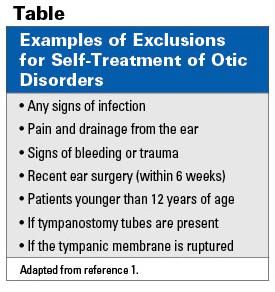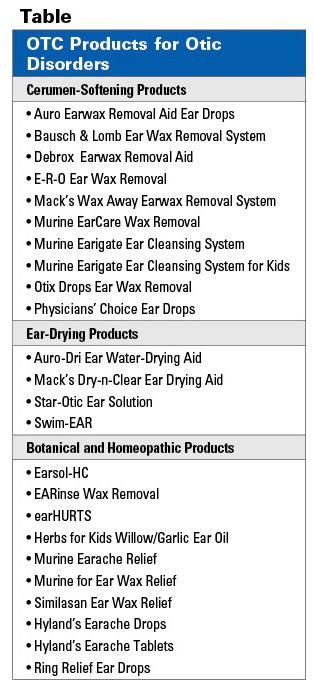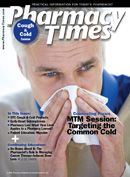Publication
Article
Pharmacy Times
Otic Disorders
Author(s):
The FDA has approved various OTC products for the self-treatment of external auditory canal disorders, including products for the removal of excessive/ impacted cerumen and water-clogged ears. These products should only be used for the treatment of external conditions which affect the auricle and the external ear canal.1 Examples of other self-treatable conditions involving the auricle include dermatitis (contact and allergic), psoriasis, and seborrhea; OTC products that are used to treat these conditions when they occur on other parts of the body are also suitable for treating the auricle.1
Excessive/Impacted Cerumen
Excessive cerumen, commonly referred to as wax buildup, is perceived as one of the most prevalent otic disorders. Approximately 4% of the general population and an estimated 50% of the elderly population experience episodes of impacted cerumen. The elderly patient population may experience impacted cerumen due to atrophy of the ceruminous glands and also secrete drier cerumen which is more difficult to push out of the ear.1,2
Patients with excessive or impacted cerumen may describe symptoms such as a feeling of fullness, pressure, or dull pain in the ear and sometimes may experience a gradual loss of hearing.1 Individuals with abnormally narrow or misshapen external auditory canals may be more susceptible to episodes of excessive/impacted cerumen.1 Individuals who routinely use earplugs or earpieces and those who wear hearing aids may experience episodes of impacted cerumen more frequently, because objects worn in the ear can physically push earwax farther into the ear canal, thus leading to impaction.1,2 Excessive wax can affect the overall performance of hearing aid devices and cause hearing aid discomfort, a reduction in the ability to hear clearly, and damage to the hearing device itself.1,2
Carbamide peroxide 6.5% in anhydrous glycerin is the only FDAapproved, nonprescription, cerumensoftening agent for individuals aged 12 and older. Cerumen-softening products can be used twice daily for up to 4 days. If symptoms persist after 4 days, patients should be referred to their primary health care provider for further treatment. If any cerumen remains after use of cerumen-softening products, it should be removed with gentle, warmwater irrigation using a rubber otic bulb syringe.1,2 During counseling, patients should be advised on the proper use of these products and reminded that improper or excessive attempts to remove cerumen may cause damage to the external auditory canal. Patients should be reminded to never insert objects such as cottontipped applicators or bobby pins into the ear to remove earwax.
Water-Clogged Ears
Due to the shape of an individual’s ear canal or the presence of excessive cerumen, some individuals may be more prone to an increased incidence of water-clogged ears. Excessive cerumen may cause swelling, which in turn may trap water in the ear. Other factors that may precipitate water-clogged ears include excessive sweating, swimming, and humid climates.1 Patients may experience symptoms that can include a sensation of wetness and fullness in the ear. If left untreated, water-clogged ears may cause tissue maceration, which may result in both inflammation and infection of the external auditory canal—typically referred to as external otitis media or “swimmer’s ear.”1
The OTC products available for water-clogged ears have been reformulated to contain only FDA-approved ingredients, and manufacturers may no longer label an OTC product as preventing “swimmer’s ear.” Isopropyl alcohol 95% in anhydrous glycerin 5% is the only FDA-approved “ear drying” agent that has been proven to be safe and effective.1
These products are indicated for use in individuals aged 12 and older. Prior to recommending any of these products, pharmacists should find out if self-treatment is appropriate and refer patients for medical care when warranted. Nonpharmacologic measures that can be used by patients, particularly those susceptible to water-clogged ears, include tilting the affected ear to drain the water or using a blow dryer on a low setting immediately after showering or swimming to dry the ear canal.1 A small portable device designed specifically for drying the ears is marketed as Mack’s EarDryer (McKeon Products Inc).
Conclusion
During counseling, pharmacists should ensure that patients understand how to use these products properly and advise

patients to contact their primary health care provider if symptoms worsen or show no signs of improvement after 4 days of therapy. Furthermore, patients should monitor their condition for any signs of infection, such as ear discharge, hearing loss, or fever, and immediately seek medical attention if symptoms show signs of worsening or if they experience severe pain, hearing loss, or dizziness.
Patients also should be advised about the importance of proper ear hygiene and that they should not insert any objects into the ear to remove earwax so as not to cause injury to the ear canal. In addition, patients should be aware of those conditions where selftreatment is not appropriate and when they should seek immediate medical attention (Table).

For pharmacist-recommended Ear products, please visit the Eye and Ear Care category at www.otcguide.net.







